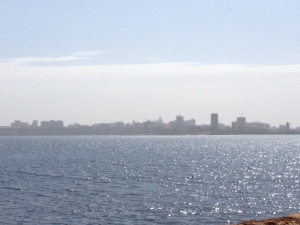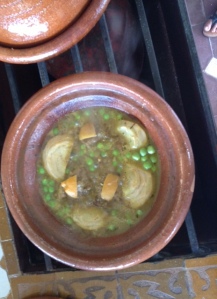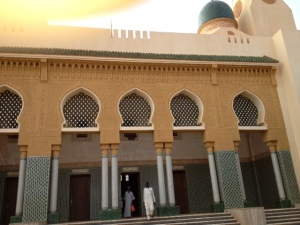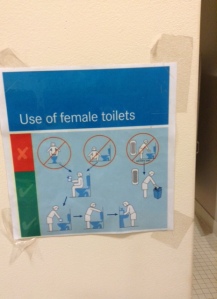The Conviction of Hissène Habré
Today, the Extraordinary African Chambers in Senegal convicted former Chadian dictator Hissène Habré, who ruled from 1982 to 1990, of crimes against humanity. Habré is accused of 40,000 politically-motivated killings and the torture of approximately 200,000 people before he was overthrown by the current…president Idriss Déby, who was his former chief military advisor.
Earlier this month, Human Rights Watch produced a very helpful Q&A: The Case of Hissène Habré before the Extraordinary African Chambers in Senegal.
Another interesting read is Our Man in Africa, for context on Habré’s relationship with the United States, which sought to counter Qadhafi in Libya.

SOURCE: @AFPAfrica
The Trans Sahara Counter Terrorism Partnership: Building Partner Capacity to Counter Terrorism and Violent Extremism in the Sahel & Maghreb
A few months ago, I published the study I had been working on during my IPA Assignment at the Center for Complex Operations at National Defense University – The Trans Sahara Counter Terrorism Partnership – Building Partner Capacity to Counter Terrorism and Violent Extremism. The study discusses the origins of TSCTP, which is rather unique by U.S. government standards, for its regional and interagency focus . It dissects the “anatomy” of the program (including which U.S. government agencies are involved, what their roles are, and who their partner nation counterparts are), and derives six functional areas of TSCTP engagement in order to better understand the program’s lines of effort across the various agencies. These are: Military Capacity-Building, Law Enforcement Anti-Terrorism Capacity-Building, Justice Sector Counterterrorism Capacity-Building, Public Diplomacy and Information Operations, Community Engagement, and Vocational Training. The study then discusses some of the planning and implementation challenges associated with a program of this nature, derived from the over 70 interviews I conducted across the interagency and in nine of the ten TSCTP countries (Algeria, Burkina Faso, Chad, Mali, Mauritania, Morocco, Niger, Nigeria, and Senegal) last year.
The study contains a lot of information on TSCTP, but as it’s rather dense, I also published a handful of shorter articles that either summarize or draw out some of the more salient points of the larger study:
- Catch-22 in the Sahel in the National Interest
- Nine Questions about the Trans Sahara Counter Terrorism Partnership you were too Embarrassed to Ask in War on the Rocks
- North and West Africa Seek to Jumpstart Regional Counterterrorism Cooperation in World Politics Review
Happy reading!
Return to the Mothership
Yesterday was my first day back at CNA, the place I’ve affectionately called “The Mothership” for the past fifteen months of my assignment at the Center for Complex Operations. While at CCO, I was working on an analysis of the Trans Sahara Counter Terrorism Partnership (TSCTP), which is an interagency U.S. government program to counter terrorism and violent extremism in the Maghreb and Sahel. I’m hoping my report will be published by the end of February – inshallah.
Working on this project, I learned a lot about the complexity of foreign assistance, and how much more I have yet to learn on the topic. I’m a very hands on learner, so fortunately I had to travel to nine of the ten TSCTP countries. At the time I traveled, I’d accordingly code-named them for security reasons: African Country A (Niger), African Country B (Chad), African Country C (Mali), African Country D (Senegal), African Country E (Morocco), African Country F (Algeria), African Country G (Nigeria), African Country H (Mauritania), and African Country I (Burkina Faso).
Here’s a few pics from my travels & some blurbs about the kinds of things I got myself into when I wasn’t working.

View of the Niger River from my hotel room in Niamey

Niger Police Academy course

View of Dakar skyline from overloaded speedboat. When asked if the boat would make it back to Dakar, the guy driving said “On va essayer!” (We’re going to try!)

Riding a camel was on the bucket list, even though it’s très touristy. But I didn’t like the way this dude was looking at me.

I made my first tajine! It had chicken, peas, and artichokes. It was compellingly mediocre – but my teacher was not to blame.

The real reason my tajine was uninspiring was b/c THERE WERE KITTENS!!! I played with them instead of listening to the instructor.
Comments on President Obama’s Africa trip & US-Africa relations published in Think Africa Press
Today, President Obama kicks off his second visit to Africa as since becoming president, and will be visiting Senegal, South Africa, and Tanzania over the course of the next week. Accordingly, Thomas Tieku, Mwangi Kimenyi, Cobus van Staden, Witney Schneidman, and I are featured in Think Africa Press’ Experts Weekly: What Next for US-Africa Relations?
My comments in particular refer to the emphasis the Administration placed before the President’s visit to the continent in 2009 on including Ghana in a multi-region tour that included Russia and the G8 in Italy to demonstrate that Africa was ‘not a world apart, but a part of our interconnected world.’ (See the reference to this concept in the full text of his July 2009 Ghana speech). Four years later, this emphasis has been lost. Check out the rest of what I have to say about the significance of the President’s visit, as well as the contributions of my colleagues!
Key questions for African-initiated intervention force for eastern DRC
On August 7th and 8th, International Conference on the Great Lakes Region (ICGLR) heads of state met to discuss the deployment of an international force to fight the M23 rebel movement that has been active in the Democratic Republic of the Congo’s (DRC) North Kivu region since April of this year. While they did not end up reaching a consensus on an intervention force, I still thought I’d attempt to think through the kind of questions that would need to be answered to establish such a force.
- What would the mission be? Like the current discussions the Economic Community of West African States (ECOWAS) is having about a regional intervention force for Mali, it will be essential for regional stakeholders to articulate what their objectives are and what their concept of operations might be in order to attain said objectives. Will they be focusing on fighting M23, or will they also be addressing instability caused by the Raia Mutomboki? Would this force attempt to address the underlying causes of the ongoing conflict in North Kivu, which could be a long-term commitment that would surpass a purely military intervention? Would this force focus on protecting civilians while allowing the Armed Forces of the DRC (FARDC in French) to deal with rebel groups? Starting to answer these types of mission-oriented questions would be a prerequisite for obtaining African Union (AU) and United Nations (UN) mandates, which could facilitate international support – which gets to my next question.
- Who would pay for this deployment?Troop-contributing countries (I’ll get to who they might be in a minute) would need to determine whether they can afford to pay the salaries of the units they would deploy, the use of (or acquisition of) contingent-owned equipment during the deployment, the transport of military assets to the eastern Congo, and the maintenance of these assets in the field. (I’m sure I forgot something, but you get the picture.) If troop-contributing countries cannot foot the bill, then the AU, UN, European Union (EU), United States would need to be willing and capable of providing financial assistance – either on a bilateral basis or on a multilateral basis – which gets to my next question.
- What framework would be used for an intervention force? The UN already has just under 20,000 military and police personnel as part of the UN Organization and Stabilization Mission in the DRC(MONUSCO), but it is possible that the UN (and the AU for that matter) are overtasked, both globally and in the DRC itself. Therefore, we might be looking at a sub-regional organization taking the lead akin to what ECOWAS is attempting to do in Mali. Unlike the situation in Mali, however, the DRC is not a member of a sub-regional organization that has a functional security component with a precedent for regional military intervention. The DRC is a member of both the Economic Community of Central African States (CEEAC in French) and the Southern African Development Community (SADC), and these sub-regional organizations are supposed to have regional brigades that would fall under the African Standby Force (ASF). However, I don’t know whether the SADC Standby Force Brigade (SADCBRIG) or its CEEAC equivalent, the Central African Multinational Force (FOMAC in French), would be willing and capable of leading an intervention force. Therefore, if there is no sub-regional organization that has an established military component is able to take the lead, then how would this intervention force be comprised?
- Who would the players be? Since we don’t know whether a sub-regional organization or a multilateral coalition of countries would intervene in the DRC, it’s difficult to ascertain which countries could be part of this notional force. But since the ICGLR is talking about such a force, we’ll start with their members: Angola, Burundi, the Central African Republic, the Republic of the Congo, the DRC, Kenya, Rwanda, Sudan (not sure if South Sudan is a member), Tanzania, Uganda, and Zambia. If I were compiling an intervention dream team from these members, I would want Angola, Kenya, Rwanda, and Uganda on my team. Why these and not the others? Off the top of my head, these countries have reasonably professional militaries with proven warfighting capabilities, are active in AU and UN peacekeeping operations (with the exception of Angola), and have countries stable enough that deploying soldiers abroad would probably not inhibit their armed forces from addressing other national security threats. That said, many of these countries have baggage in the DRC as a result of their involvement in the 1998-2003 civil war (Angola, Rwanda, and Uganda), or more recently, alleged support for M23 (ahem…Rwanda). Also, would these countries even be interested in intervening? I would say Rwanda would because of the threat it perceives from the Democratic Forces for the Liberation of Rwanda (FDLR). Angola’s participation would depend on the extent to which its security is affected by events on the opposite side of the Congo, as well as the extent to which the ruling People’s Movement for the Liberation of Angola (MPLA in Portuguese) feels more comfortable keeping the military at home in case there is instability surrounding this month’s elections or to contain additional protests by civil war veterans. And while I don’t think Kenya has baggage in the DRC, I doubt that instability in North Kivu is compelling enough to deploy the Kenya Defence Forces (KDF) there when their focus is really on Somalia. Thus, the militaries that might be the most capable of fighting M23 in North Kivu may either fail to be perceived as a neutral force or their countries lack a compelling reason to get involved. As a result, an intervention force might have to look further afield to get troop contributors or make do with less capable forces.
So I guess the bottom line is that I don’t think an intervention force will come to fruition for the eastern Congo due to some of the issues I’ve raised above.















You must be logged in to post a comment.